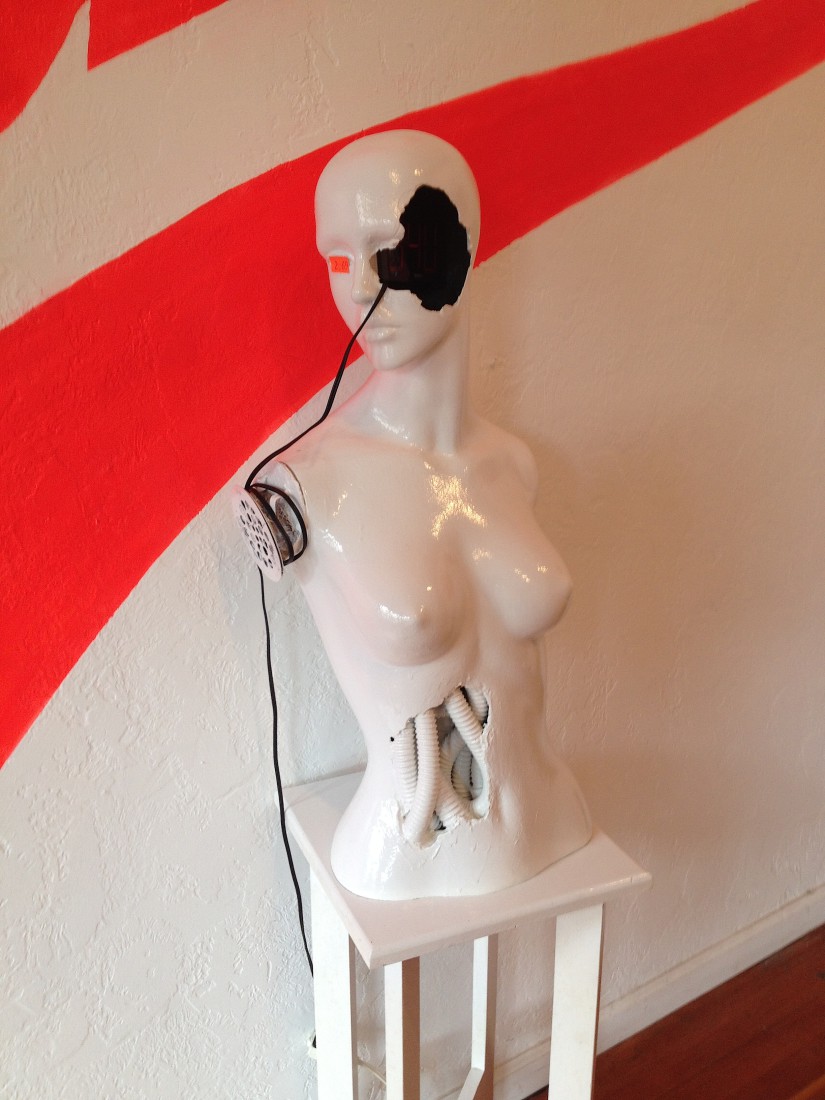The word “fame” is painted directly on the wall beside the Satellite Gallery’s entrance in 12-foot-tall letters. It’s written in the wispy Coca-Cola script, but in a gluttonous and vibrating pinkish orange rather than the patented cherry red color, and it introduces The Fame Game, a new collaborative exhibition by Asheville artists Yamabushi and Ishmael.
The show is a rumination on fame as a promotional utility and an idyllic condition. It’s simultaneously a societal critique and an embrace — an archetypal cost-benefit analysis, if you will. And for a show that’s so concentrated on image and identity, there’s very little ego.
Below the title work is a porcelainlike plastic mannequin. Her torso is perched atop a pedestal. Her downcast face has been cracked open and stuffed with a small bedside digital clock and her abdomen has given way to reveal a tangle of robotic tubes. Largely because of her armlessness, she has the airs of a defunct and disgraced Venus de Milo — fame personified.
The Fame Game is thematically collaborative, but in practice it’s more like two exhibitions folded together, as Ishmael and Yamabushi’s artistic styles and contextual direction couldn’t be further apart. Because of that, the show comes across as an expressive duel. A shot-for-shot interpretation of what fame has to offer both the individual and society at large.
Where Yamabushi’s crafted a celebratory series of lurid, roller-disco-esque iconographies, Ishmael has painted a searing damnation of American consumer culture. And where Ishmael’s largely stuck to the black and white palette of oil slicks, barring the occasional neon highlight, Yamabushi has responded with glitter and gold.
Twelve of Yamabushi’s works feature a grid of celebrity. The alternating red paint and glitter squares hold a dozen figures, each framed by flamboyant gold brackets or psychedelic halos. Some sport names like “The Shadow Girl” or “Game.” Others are simply deadlocked in a gaze with viewers. In “Worlds Without Ends,” a solitary hero figure who has the look of a rogue detective in a ’70s crime thriller, stares into eternity. His mouth is slightly open, and his eyes are replaced by blue glitter. He’s backlit by a flurry of rainbows and hallucinatory, bouncing icons and kaleidoscopelike circles.
Ishmael’s work, conversely, takes on globalization and the consequential downfalls that can result from the exuberant societal highs seen in Yamabushi’s art. In “The Source: Food and Agriculture Organization” and “Dust Bowl” food production is tracked. The former is a food and population growth (and soon-to-be death) chart. The latter shows a farm and a farmhouse become a wasteland and an abandoned shack. He also takes aim at the 2010 oil spill in the Gulf of Mexico — an event whose presence has been steadily slipping from the national consciousness. The gravity of Ishmael’s work on the subject would have been heavier in years prior, but that’s not to discount his creative prowess.
In “Mark of the Beast,” the artist has configured three gas pumps in a loose triangle. The silhouette of a cobra functions as both a poisonous warning and a connection to the legendary Shelby muscle car. A neon-toned gas gauge steadfastly approaches “E.” Another small panel depicts a sinking cargo ship whose name, coldly, is “Civilization.”
The most scathing of Ishmael’s consumption-themed works offers a gruesome depiction of one of mankind’s most detrimental environmental impacts to date. And it names names. “BP Wuz Here” features a wall-mounted 5-foot-long swordfish trophy. It’s entirely blacked out, barring a single visible red eye. The thick, viscous paint-turned-oil drips off the fish and down the white gallery walls before pooling up on the floor below. The fin is tagged in green spray paint, a tongue-in-cheek calling card: “BP Crude Boy$.”
The Fame Game is on view at the Satellite Gallery through Sunday, July 20. thesatellitegallery.com.



Before you comment
The comments section is here to provide a platform for civil dialogue on the issues we face together as a local community. Xpress is committed to offering this platform for all voices, but when the tone of the discussion gets nasty or strays off topic, we believe many people choose not to participate. Xpress editors are determined to moderate comments to ensure a constructive interchange is maintained. All comments judged not to be in keeping with the spirit of civil discourse will be removed and repeat violators will be banned. See here for our terms of service. Thank you for being part of this effort to promote respectful discussion.